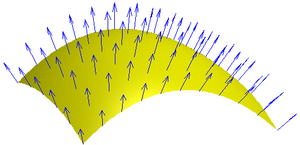- Represented by the Greek letter Φ (phi)
- Measure of quantity of magnetism, taking into account the strength and the extent of a magnetic field.
- The SI unit of magnetic flux is the weber (in derived units: volt-seconds), and the unit of magnetic field is the weber per square meter, or tesla.
Description:
- The flux through an element of area perpendicular to the direction of magnetic field is given by the product of the magnetic field and the area element. More generally, the magnetic flux at any angle to a surface is defined by a scalar product of the magnetic field and the area element vector.
- The direction of the magnetic field vector B is by definition from the south to the north pole of a magnet (within the magnet). Outside of the magnet, the field lines will go from north to south.
- The magnetic flux through a surface is proportional to the number of magnetic field lines that pass through the surface. This is the net number, i.e. the number passing through in one direction, minus the number passing through in the other direction.
- Quantitatively, the magnetic flux through a surface S is defined as the integral of the magnetic field over the area of the surface (See Figures 1 and 2):
where
 is the magnetic flux
is the magnetic flux- B is the magnetic field,
- S is the surface (area),
 denotes dot product,
denotes dot product,- dS is an infinitesimal vector, whose magnitude is the area of a differential element of S, and whose direction is the surface normal. (See surface integral for more details.)
In the special case where the surface S is a planar surface with area A, and the magnetic field is constant with magnitude B, the formula simplifies to
where θ is the angle between B and the surface normal to S.
The magnetic flux is usually measured with a fluxmeter. The fluxmeter contains measuring coils and electronics that evaluates the change of voltage in the measuring coils to calculate the magnetic flux.
Magnetic flux through a closed surface
which is one of the four Maxwell's equations, states that the total magnetic flux through a closed surface is equal to zero. (A "closed surface" is a surface without boundaries, such as the surface of a sphere or a cube, but not like the surface of a disk.) This law is a consequence of the empirical observation that magnetic monopoles have never been found.
In other words, Gauss's law for magnetism is the statement:
Magnetic flux through an open surface
While the magnetic flux through a closed surface is always zero, the magnetic flux through an open surface is an important quantity in electromagnetism. For example, a change in the magnetic flux passing through a loop of conductive wire will cause an electromotive force, and therefore an electric current, in the loop. The relationship is given by Faraday's law:
where (see Figure 3):
- E is the EMF,
- Φm is the flux through a surface with an opening bounded by a curve ∂Σ(t),
- ∂Σ(t) is a closed contour that can change with time; the EMF is found around this contour, and the contour is a boundary of the surface over which Φm is found,
- dℓ is an infinitesimal vector element of the contour ∂Σ(t),
- v is the velocity of the segment dℓ,
- E is the electric field,
- B is the magnetic field.
The EMF is determined in this equation in two ways: first, as the work per unit charge done against the Lorentz force in moving a test charge around the (possibly moving) closed curve ∂Σ(t), and second, as the magnetic flux thorough the open surface Σ(t).
Comparison with electric flux
By way of contrast, Gauss's law for electric fields, another of Maxwell's equations, is
where
- E is the electric field,
- S is any closed surface,
- Q is the total electric charge inside the surface S,
- ε0 is the electric constant (a universal constant, also called the "permittivity of free space").
Note that the flux of E through a closed surface is not always zero; this indicates the presence of electric "monopoles", that is, free positive or negative charges.
MAGNETIC FIELD STRENGTH
Magnetic fields
surround magnetic materials and electric currents and are detected by the force they exert on other magnetic materials and moving electric charges. The magnetic field at any given point is specified by both a direction and a magnitude (or strength); as such it is a vector field.[1]









No comments:
Post a Comment